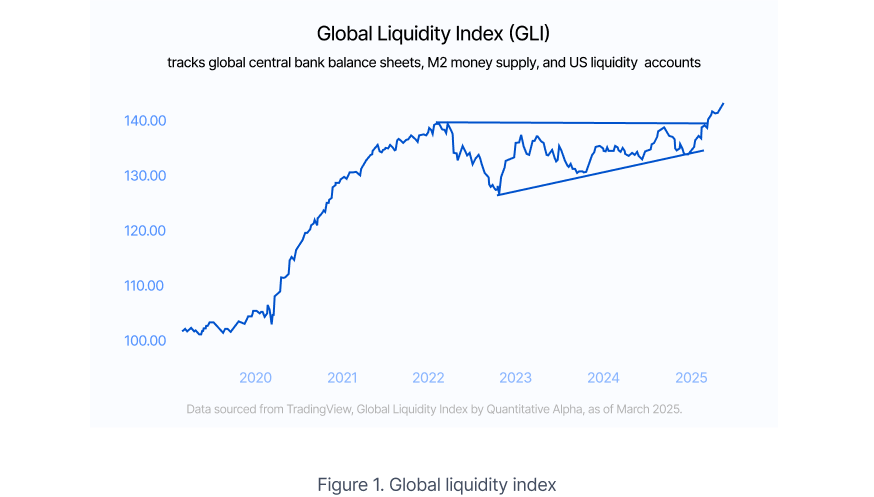Navigating 2025: Inflation, interest rates & market volatility
As we move through 2025, the global economic landscape continues to be shaped by complex and volatile forces. Persistent inflationary pressures, increasingly divergent central bank policies, and intricate geopolitical dynamics are driving uncertainty.
The first half of 2025 has already demonstrated this turbulence from the lingering impact of Trump’s tariffs to ongoing conflicts such as the Russia-Ukraine war and tensions in the Middle East. These developments have added pressure to traditional asset classes and contributed to increased market fluctuations.1
Adding to this complexity, the recent escalation of tariff risks with potential 30% duties on EU and Mexican imports effective 1 August 2025, introduces a renewed layer of trade friction and uncertainty for the latter half of the year.2 Despite these global headwinds, the US equity market has shown resilience, supported by domestic factors and strong fundamentals.

Several tailwinds could continue to support capital markets: the anticipated rise in global liquidity shown in Figure 1, structural benefits from the One Big Beautiful Bill Act passed on 4 July 2025, and the potential for interest rate cuts by the Federal Reserve in the second half of the year.3,4
That said, the path to the rate of easing remains uncertain. Minutes from US central bank’s June meeting revealed significant divergence among Fed officials on the timing and extent of cuts, particularly regarding the inflationary impact of tariffs.5 Against this backdrop, investors may consider portfolio strategies that can navigate both global headwinds and region-specific developments. In this environment, investors are increasingly rethinking their traditional asset allocation models. Many are asking whether conventional public market exposure alone can meet their long-term goals, particularly when faced with growing macro uncertainty, sentiment-driven swings, and potential yield compression.
Why are HNWIs and institutions looking beyond public markets?
Institutional investors and high-net-worth individuals (HNWIs) are increasingly moving capital out of traditional public markets.5,6 Why?
- Public equities are vulnerable to short-term sentiment swings and macroeconomic shifts.
- Fixed income instruments, while more attractive in recent years, may still fall short for investors seeking higher real returns.
- For some investors, liquidity is becoming a trade-off in favor of long-term value creation and portfolio diversification.
As a result, many sophisticated investors are exploring private markets to access alternative strategies that can offer diversification, potential for uncorrelated returns, and reduced exposure to public market volatility.
How do private markets offer diversification, stability, and alpha?
Private markets encompass asset classes like private equity, private credit, real estate, and hedge funds. In today’s environment, they offer three critical advantages:
1. Diversification
Private assets tend to have low correlation with public markets, helping reduce portfolio volatility and smooth returns across cycles. In the current volatile market, this uncorrelated behavior has become a strategic advantage.
2. Stability
Assets like private credit and income-generating real estate offer predictable cash flows, even in rising rate environments. These serve as stabilisers during periods of public market stress.
3. Alpha Generation
Private equity and hedge funds are focused on long-term value creation. They operate outside the pressures of quarterly earnings cycles and can pursue more flexible investment timelines. Private equity has historically delivered strong returns, often surpassing public benchmarks like the S&P 500 over the long term, albeit with lower liquidity.5
How ADDX expands access to private markets
ADDX is helping reshape how investors access private markets. By combining advanced technology, regulatory compliance, and enhanced deal flow, ADDX enables accredited investors to build diversified, institutional-grade portfolios with lower minimums and greater flexibility.
On the ADDX platform, investors can access:
- Private equity funds with global exposure
- Private credit opportunities offering stable income
- Hedge fund strategies to potentially seek returns in dislocated or less efficient markets
These are all accessible through a fully digital platform offering lower minimum investment options (as low as $1,000), access to regulated secondary trading, and investments subject to due diligence. This structure enables transparent, tech-enabled investing and opens up private markets to a broader set of investors.
Discover how ADDX enables access to institutional-grade private market opportunities.
Sources:
1 https://am.gs.com/en-it/institutions/insights/article/asset-management-mid-year-outlook
2https://www.reuters.com/business/trump-announces-30-tariffs-eu-2025-07-12/
3https://finimize.com/content/why-surging-global-liquidity-could-push-this-asset-higher
6https://www.mckinsey.com/industries/private-capital/our-insights/global-private-markets-report
This article is for general informational purposes only and has not been independently verified to ensure its accuracy and fairness. This article does not constitute any advice or recommendation from ADDX or ICHX Tech Pte. Ltd. (“ICHX”) or any of its affiliates. Please consult your own professional advisors about the suitability of any investment product/securities/ instruments for your investment objectives, financial situation and particular needs. No representation, warranty or other assurances of any kind, expressed or implied, is made with respect to the accuracy, completeness, adequacy, reliability validity or availability of any information in this article. Under no circumstance shall ADDX or ICHX bear any liability to the reader for any loss or damage of any kind incurred as a result of the use or reliance on any information provided in this article. This article may not be modified, reproduced, copied, distributed, in whole or in part and no commercial use or benefit may be derived from this article without the prior written permission of ADDX and ICHX. ADDX and ICHX reserve all rights to this article.


